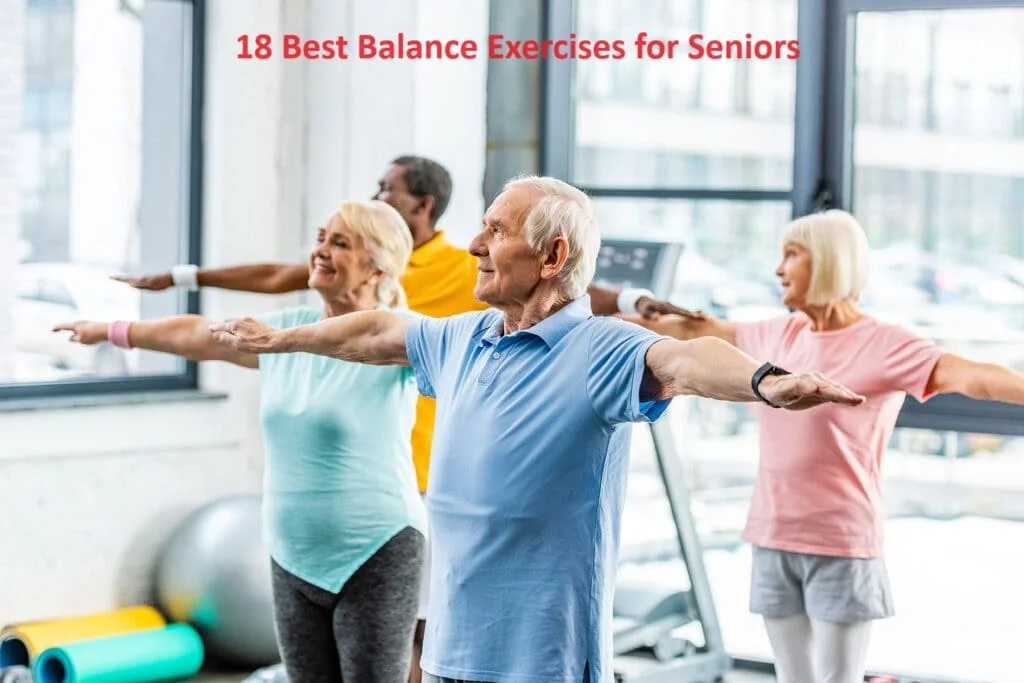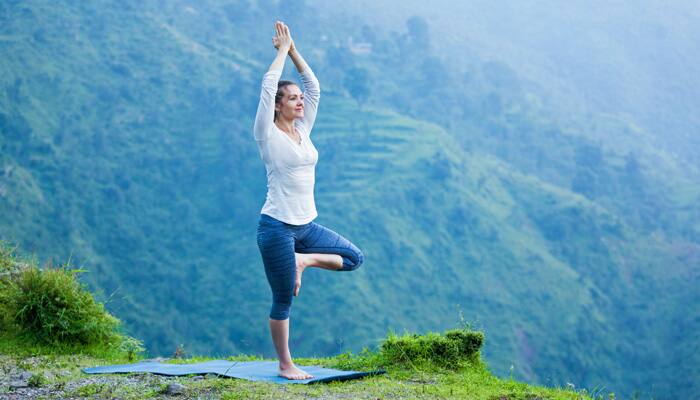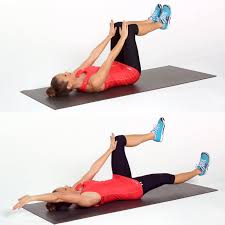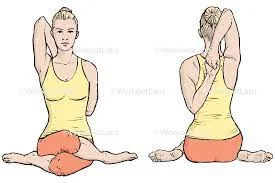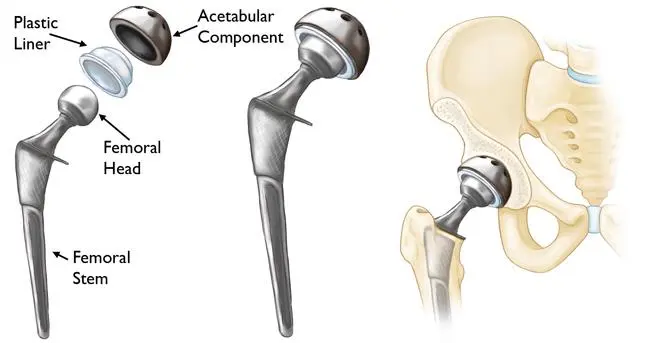18 Best Balance Exercises for Seniors
Introduction
Balance exercises are important for seniors because they can help to improve stability and coordination, and reduce the risk of falls. Falls are a major cause of injury and death among seniors, so balance exercises are essential for maintaining independence and quality of life.
The purpose of balance exercises is to increase your body’s stability and coordination. When you walk, bike, climb stairs, or dance, balance helps you maintain your balance. It’s important to take part in balance-enhancing exercises as you age.
A strong equilibrium can protect you from damage. It’s important to maintain a good balance as you age since older people are particularly weak to incidents involving slips and falls.
how important balance exercises are to improving an elderly person’s quality of life. demonstrated older person’s capacity to move independently increased after starting a regular balancing exercise program.
The exercises that are listed here are designed to improve your balance. Start them slowly, and have something nearby to grip onto if you happen to lose your balance throughout the exercise. Do not continue if you have pain. Consult your doctor if the discomfort lasts for days or weeks.
At any stage of life, but especially as you become older, exercise is important. In your senior years, you should intensify your workouts because exercise can increase flexibility and lower the risk of developing certain medical disorders.
Being active, powerful, and sure of yourself on your feet can help you maintain your independence, which can improve your confidence and general well-being as you age.
In addition to chronic sickness, the following conditions might affect balance:
- arthritis.
- migraine.
- cardiovascular disease.
- vision impairment.
- medication side effects.
A few basic balance exercises that are suitable for elders.
- Select the dominant leg in your body. Each exercise should be started on your non-dominant side to make the opposite side simpler.
- While keeping the position, keep proper form and posture.
- To keep your balance, fix your attention on a straight-ahead fixed point.
- Put your feet a little farther apart if you’re having trouble staying balanced while standing.
- The knees are slightly bent. You become more stable and your knees are kept from hyperextending as a result.
- Put equal amounts of weight on both feet. Find out if you have a tendency to lean more on one foot or if your weight tends to shift forward or backward.
Exercises to try
These exercises can be performed barefoot or with shoes on. While wearing shoes may improve your stability and grip, going barefoot may actually strengthen the stabilizing muscles in your feet.
Use a yoga mat as padding to lessen the possibility that you may slip. Find someone who can supervise you and offer assistance, if at all possible.
Modify the poses as much as you need. Over time, you’ll increase your balance and be able to move on to more difficult variations and exercises.
There are many different types of balance exercises that are appropriate for seniors
Simple balance exercises
These exercises are accessible to all levels. Exercises to Help Seniors Balance Better
All of these workouts are designed to promote your body’s natural alignment. Regularly doing these workouts can help you maintain your current lifestyle because your muscles and bones gradually deteriorate as you age. Seniors can perform these exercises at home with the help of nearby items and their own bodies to enhance their balance.
Single-Limbed Balance
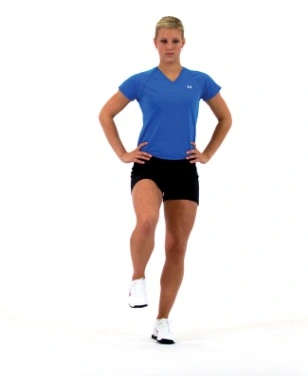
It’s best to start with a simple balance exercise for elderly people. This one should be done as follows: Hold onto the back of a chair that is stable and steady (one without wheels is best). Raising your right foot while maintaining balance on your left. For as long as you can, maintain that posture, then switch feet. The goal is to stay one-footed for as long as possible without holding onto the chair.
Walking heel to toe
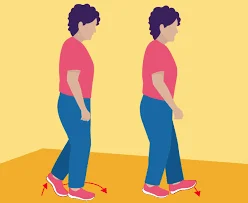
After reading this, you might be wondering how walking can help with balance. As a result of this exercise, your legs will grow stronger and you’ll be able to walk without falling.
Put your right foot in front of your left foot so that the tops of the toes on both feet are in contact. Your left foot should be in front of your right, with your weight on the left heel. Next, put some weight on your toes. Take another step with your left foot. Take this path 20 steps at a time.
Rock the Boat
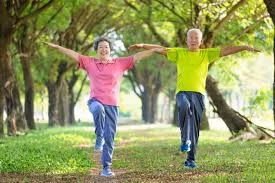
Step out until your hip size and the distance between your feet are equal. Make sure the earth is beneath your feet. Keep your head level and your body straight. Then, carefully raise your left leg off the ground and move to your right foot. (but no longer than 30 seconds).
Before moving your weight to that foot, slowly place the other foot back on the ground. Lift the leg on the other side gradually. Increase the number of repetitions after completing this balance exercise five times on each side.
Clock Reaches
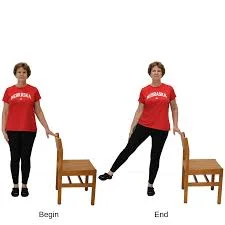
For this activity, a chair is required.
Think of yourself as being exactly in the centre of a clock. The number 12 is directly in front of you, while the number 6 is directly behind you. With your left hand, cling to the chair. As you lift your right leg, your right arm should be extended and facing the number 12. Next, point your arm in the general direction of the number 3, then turn it back to face the number 6. Before moving on to the number 12, bring your arm back to the number three. Never look back; always look forward.
For each side, perform this exercise twice.
Back leg lifts
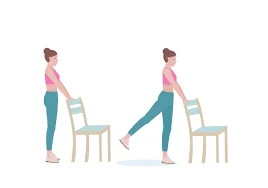
With the help of this senior strength exercise, your lower back and bottom get stronger.
Step back from a chair. Slowly raise your right leg straight back, being careful not to point your toes or bend your knees. After one second, pause before slowly extending your leg. For each leg, repeat this ten to fifteen times.
Arm in Single-Limbed Stance
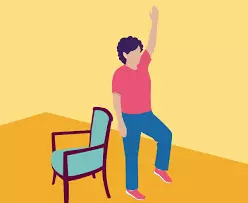
Your physical coordination will be improved by this balance exercise for elders.
With your feet together and your arms by your sides, take a stance next to a chair. Over your head, raise your left hand. After that, gradually lift your left foot off the ground. For ten seconds, maintain that posture. On the right side, carry out the same action.
Side Leg Kicks
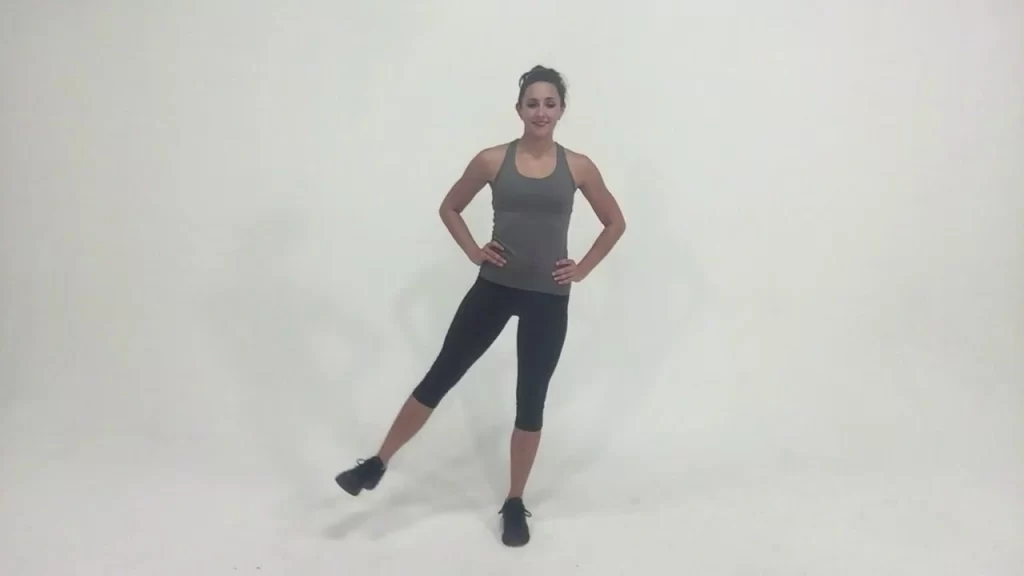
For this balance-enhancing workout, you’ll need a chair.
Your feet should be slightly apart as you stand behind the chair. Raise your right leg to the side gradually. Your toe should be pointed forward as you maintain a straight posture. Slowly lower your right leg. Ten to fifteen times per leg, repeat this exercise.
Wiggling Wand
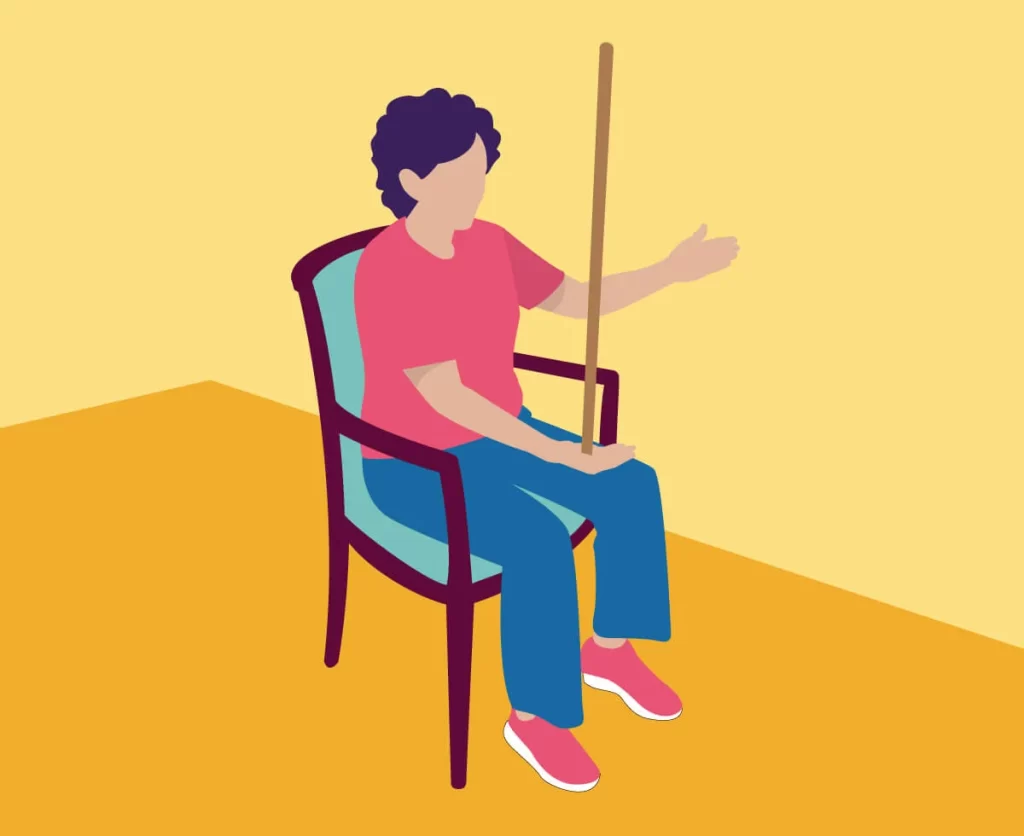
The elderly may perform this balance exercise while seated.
You’re going to need a cane or some other kind of staff. A broomstick works excellently for this; just remove the head before you start.
The bottom of the stick should be flat against the palm of your hand as you hold it. The goal of this exercise is to keep the stick upright for as long as you can. Change hands to work on your balance on both sides of your body.
Wall push-ups
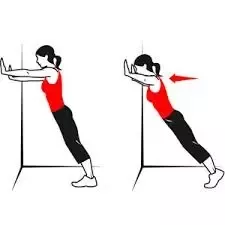
You may perform this strength training exercise for seniors anywhere there is a wall.
Place yourself in front of a blank wall without any artwork, ornaments, windows, or doors at arm’s length. Put your palms flat at shoulder height and width on the wall while leaning slightly forward. Keep your balance as you gently glide your body towards the wall. until your arms are straight, slowly pull back. Produce 20 of these.
Marching in place
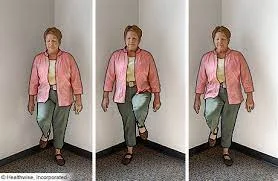
Seniors can improve their balance by marching. If you need something to grasp onto while exercising, stand in front of a counter. Standing straight, raise your right knee as high as you can. Lift your left leg first, then lower it. 20 times, raise and drop each leg.
Toe Raise
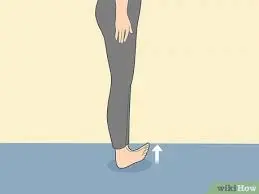
This senior strength training exercise improves balance. Either a counter or a chair is required.
Place your arms out in front of you while standing upright. As high as you can, raise yourself up on your toes; then, slowly descend yourself. Avoid slouching too much forward on the counter or chair. Twenty times, raise and lower yourself.
Rolled shoulders
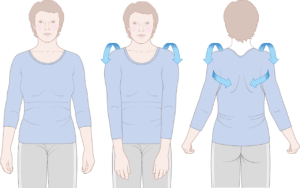
This senior workout is easy to do. Both sat and standing are acceptable.
Swing your shoulders gently up to the ceiling, then back and down. Next, follow the same steps, but roll them backward instead of forward.
Finger & Hand Exercises
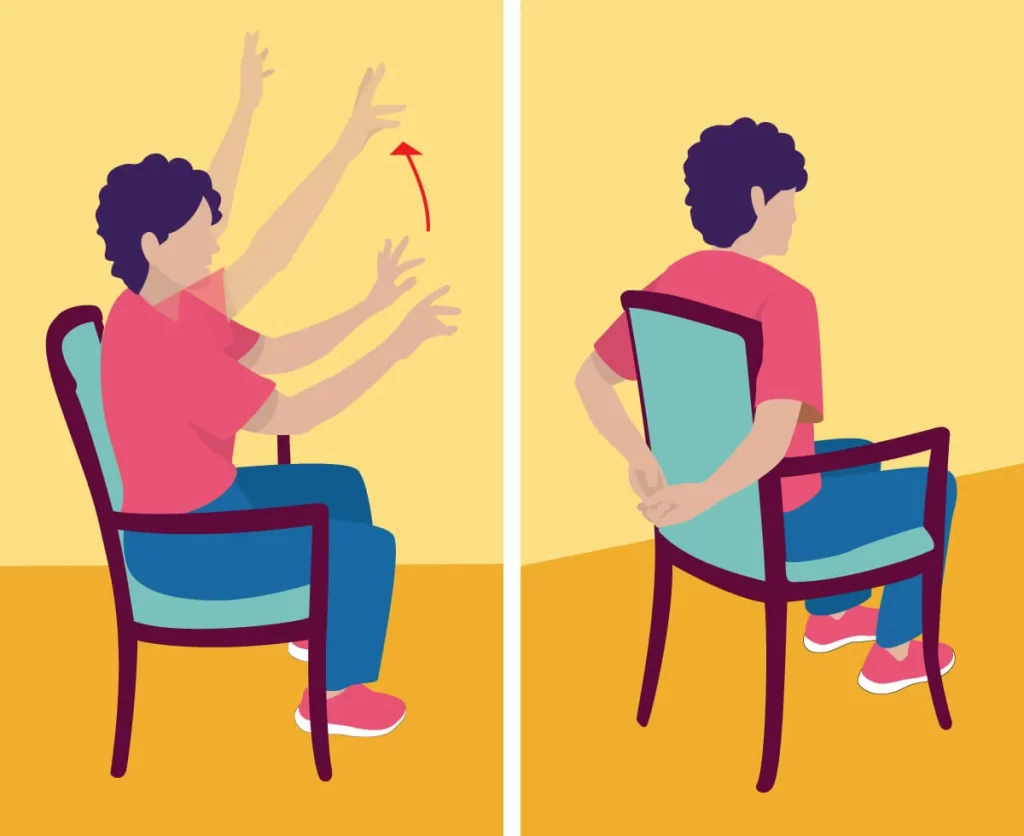
The exercises listed below will help you become more flexible. You are not required to support these.
For the first exercise, imagine that a wall is in front of you. Your fingers’ tips will elevate the wall until they are above your head. Holding your arms over your head, twist your fingers for 10 seconds. Then, carry them back down.
Touch your hands behind your back while you perform the second exercise. With your right hand behind your back, reach for your left hand. Try it with your other arm after holding that position for ten seconds.
Calf stretches
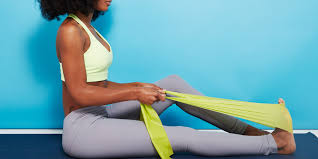
Seniors can carry out these strengthening exercises whether sitting or standing.
Find a wall that is empty so that you can stand and stretch your leg muscles. Standing with your back to the wall, place your hands at eye level. You should have your left leg behind your right. While maintaining your left heel planted, bend your right knee.
For 15 to 30 seconds, maintain the stretch. Each leg should be repeated two to four more times.
You’ll need a towel if you want to stretch your calves while sitting. Sit on the soft mat with your legs keep forward-straight. The towel should be grasped at both ends and wrapped around the soles of your right foot. Pull the towel towards you while keeping your knee straight, and hold it there for 15 to 30 seconds. During the workout, each leg should be exercised two to four times.
Lunges
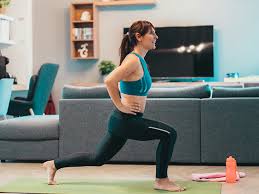
When walking, you frequently take a step forward or backward to regain your equilibrium. By performing lunges, you can keep this capacity.
Step 1: Take a standing position with your back straight and your hands on your hips.
Step 2: Next, flex your knee and forward your right foot. Your right thigh should be parallel to the ground as you fall.
The next action is to inhale, hold it for 30 seconds, and then softly resume your starting position. Move on to the left leg.
For each leg, repeat this five to 10 times.
Flamingo Stand
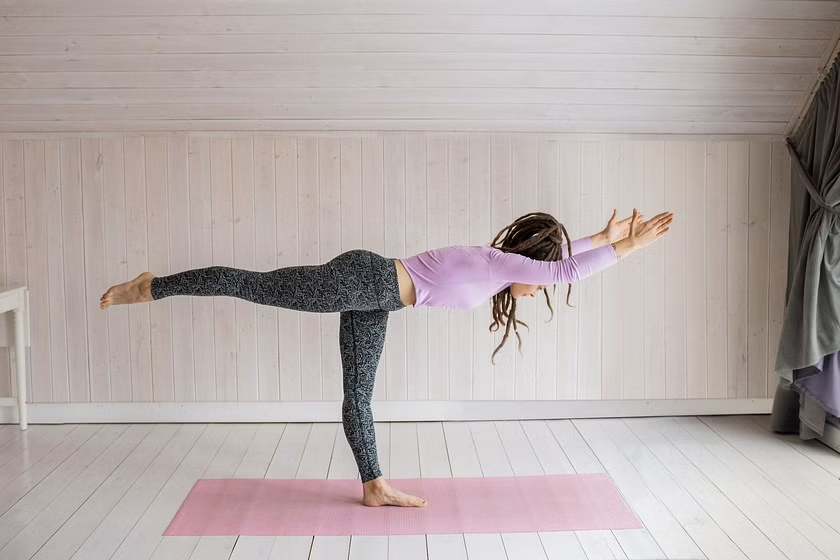
This exercise strengthens the hip muscles while also stabilizing the core. Do this while positioned close to a wall that you can use as support.
STEP 1: Start by standing with your feet shoulder-width apart and touching a wall with your hands.
Step 2: Now, as if you were marching, lift your right leg up to your hip. Lower it, then lower the left, and repeat.
Step 3: Step up the pace or lift your legs higher to make it more tough.
Repeat between 10 and 20 times for both sides.
Walk the Tightrope
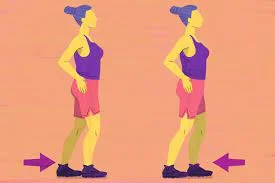
For this job, use whatever straight line you can find, such as the spaces between floor tiles or the edges of tape.
Step 1: Decide where you want to walk first.
Step 2: As if you were walking a tightrope, extend your arms out to the sides and start to stroll slowly. Pay close attention to the ground at all times.
Step 3: Switch from your heel to your toe, holding for at least five seconds in time.
Once every day, try this exercise to keep your coordination strong.
Tree Pose
The tree position is a great and simple balance exercise to do after your single-leg balance. This exercise is a common yoga posture. A chair should be nearby while you work.
Step 1: Holding one hand to your chest and the other on a chair, stand with your feet shoulder-width apart. If it’s more comfortable for you to do so, you can also place both hands on your chest.
Step 2: Straighten out your right leg now, pointing your foot inward. Place your right foot’s sole against the side of your left thigh.
Step 3: The third step is to maintain this posture for at least 30 seconds, or even longer if you can.
Repeat this exercise three times while using the other leg.
Exercise With a balance board:
The next two exercises call for the use of a balance board.
tilting both forward and backward, side to side

To perform forward and backward tilt exercises on a balance board, follow these steps:
- Place your feet shoulder-width apart as you stand on the balance board.
- Maintain a firm core and a straight back.
- Slowly tilt the board forward until you feel your abdominal muscles contract.
- Slowly tilt the board back until you feel your hamstrings and glutes contract.
- Continue to tilt the board forward and backward for 30-60 seconds.
Single-foot balance.
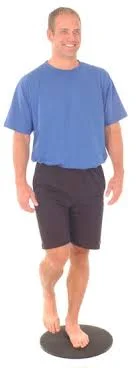
If you find this exercise too challenging, you can start with your feet closer together or by holding on to a chair for support. As you get stronger, you can gradually increase the difficulty by standing on one leg or by adding weights.
Forward and backward tilt exercises on a balance board are a great way to improve your balance, core strength, and stability. They are also beneficial for injury prevention and rehabilitation.
Here are some tips for performing forward and backward tilt exercises on a balance board safely:
- As you gain strength, start out easy and progressively raise the effort.
- Throughout the entire workout, maintain a tight core and a straight back.
- Focus on maintaining your balance and control.
- If you feel yourself losing your balance, stop the exercise and try again.
- If you have any pain, stop the exercise and consult with a doctor or physical therapist.
Exercise With a walker
Marching
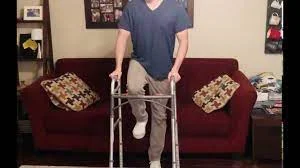
Stand with your walker in both hands.
Do your best to raise your left knee.
Lift your right knee, then let it go.
For a total of 20 repetitions, switch sides.
Heel-toe lifts
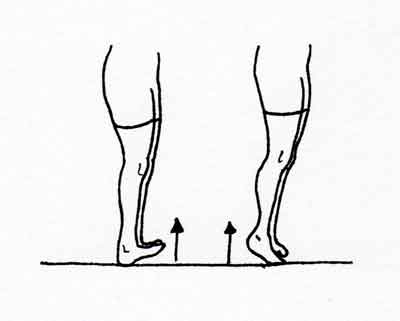
Stand with your walker in both hands.
Lift both heels and maintain a three-second balance on the balls of your feet.
Then place your heels under the weight and point your toes upward.
Perform 10 to 20 times.
Cautions
A balanced treatment can be very helpful for seniors, but you should still proceed with caution. To prevent falls, use a chair or a wall as additional support. Work your way up to the more difficult exercises by beginning with the simpler ones.
Sit down and take a rest if needed. Be careful to eat and drink enough of water prior to doing these exercises. This will help you feel safer, especially if you are concerned about being lightheaded or unsteady.
If you’re new to exercise or have any concerns about your balance, talk to your doctor before starting a new training regimen.
You should also speak with your doctor if you have any health issues, a history of a heart attack or stroke, or any other medical conditions.
Benefits
Exercises for balance can improve posture, stability, and coordination while also strengthening muscles. These advantages may reduce your risk of hurting yourself by falling or bumping into things. If you do fall, you cannot recover from an injury as quickly, so it’s better to take precautions.
Older persons must feel confident in their movement styles in order to avoid anxiety or fear of falling.
Six weeks of balancing training improved the balance control and confidence of older persons. Additionally, the activities enhanced ankle mobility, leg strength, and coordination.
the efficiency of balance and coordination activities in raising older individuals’ general quality of life. Exercises for balance can have both physical advantages, such as improved stability, and mental advantages, such as memory and spatial cognition.
It is advised that older persons exercise at least twice or three times per week.
Greater Risks
The risk of falling in older people is often impacted by a variety of factors, including:
issues with walking or balance. Vision abnormalities, vestibular issues, and changes in the feeling in the feet can all influence balance.
the taking of numerous drugs. When using five or more prescription drugs, people are more prone to trip and fall.
Home dangers (such as dim lighting and trip hazards)
When someone suddenly stands up, they experience positional hypotension, which causes their blood pressure to drop.
Foot and shoe problems
Falls frequently happen while sitting, standing, or using the toilet or shower in the bathroom, or late at night in a dark bedroom when getting up fast and falling on the way to the restroom.
Exercises to Prevent Falls
While falling is not totally preventable, workouts that focus on balance and strength training help lessen the risk of falling. We treat senior patients who have fallen and suffered injuries as well as other patients who feel unsteady when walking or standing and fear falling. physically therapeutic These exercises can strengthen the body and increase the balance to reduce the risk of falling in the future.
The danger of falling increases for older people when they find it difficult or unsteady to do activities including squatting, getting up from a chair, and walking. The exercises were designed for those who can stand independently and have a low risk of falling.
Before beginning any new workouts, always consult your doctor or physical therapist, especially if you have poor balance.
Balance Exercise
If your balance is unstable, try these exercises. In case you lose your equilibrium, make sure someone is nearby.
Start off by standing in a corner or with a kitchen counter in front of you so you have something to grab onto if you start to lose your balance.
- Put your feet separated. Keep your position for 10 seconds while standing with your feet shoulder-width apart and your eyes open before extending it to 30 seconds. If you regularly sway or reach for the wall or counter while performing this exercise, just keep practicing until you can do it without much swaying or support. Go on to the next exercise once you can maintain this posture for 30 seconds.
- Feet together. With practice, you can keep still for 30 seconds while standing with your feet together and your eyes wide open. Go on to the next exercise if you can do the previous one for 30 seconds without needing much assistance or wobble.
- One foot: Working up to 30 seconds, balance yourself on one foot while keeping your eyes open for 10 seconds. Change to your other foot.
- Eyes closed: If you can perform the first three exercises safely and with little support, try to do each one with your eyes closed. Up to 30 seconds can be held after 10 seconds.
For each exercise, the target time is 10 seconds, with a progression of 30 seconds, five repetitions (including five per leg for the one-foot exercise), and twice daily.
Considerations for Safety
Exercises that improve balance are important for older persons, but they must be performed cautiously. Make sure you have a stable object nearby, such as a chair, a wall, or even another person.
Take frequent rests and avoid attempting to accomplish too much at once. Before continuing, consult your doctor if you have any worries about beginning a new balance program or if you feel any pain while performing these exercises.
When to consult a professional
If you need more advice, consult a physical therapist. Your balancing program can be created by a physical therapist, who can also provide guidance as you perform each exercise.
You could feel more inspired and confident to tackle more difficult workouts if you have a partner. They can ensure that you are moving efficiently and with appropriate posture. Additionally, they will encourage you to take breaks as necessary.
Conclusion
It’s never too late to begin a fitness routine or to improve an already established one. You can improve your balance in addition to these exercises by walking, doing chair yoga, or doing tai chi.
Make it a point to move your body every day, even if it’s just for a little while. If you follow your program in this manner, you’ll be more likely to do so.
In addition to balance exercises, include stretching, cardio, and strength training in your routine. Follow a balanced diet to ensure you stay at a healthy weight for your body type.
Most importantly, keep in mind to have fun while making these positive changes to your life.
FAQs
How can someone who is 70 years old increase their balance?
7 Balance Exercises for Seniors to Boost Your Stability
rotates the head. A quick and simple workout to relax your neck and improve your posture is head rotations. …
Foot tapping,
sit-to-stand exercises,
and foot tapping
Single-legged stances,
marches in place,
Over-the-shoulder movements.
Walking on a tightrope
What makes elders’ balance so unstable?
internal ear issues. Balance is controlled by the labyrinth, a structure in the inner ear. Labyrinthitis, an inflammatory illness that causes imbalance and vertigo, develops when the labyrinth gets inflamed. The condition can be caused by specific ear conditions and infections.
What does the senior balance test involve?
The test assesses the amount of time it takes someone to get up from a chair, walk three meters (about 10 feet) to a line on the floor, and then get back down. The Berg Balance exam, the Barthel Index of Activities of Daily Living, and gait speed tests all show a good correlation with this exam.
What disease results in balance issues?
A deficiency in vitamin B-12 can cause neurological issues like persistent tingling in the hands and feet or balance issues if left untreated. Being deficient in vitamin B-12 might induce mental confusion and forgetfulness since good brain function depends on this vitamin, stomach cancer.
What organ possesses balance?
inside ears
The inner ear components that affect balance are referred to as the vestibular system. In this mechanism, three fluid-filled loops (semi-circular canals) react to head rotation. The semicircular canals are nearby, as are the utricle and saccule, which detect gravity and backward and forward motion.
Which medicines have the potential to affect the balance?
Your balance may be hanging in the balance due to medication side effects.
Antidepressants.
medicines for high blood pressure.
drugs for the heart.
anti-anxiety medications.
helps to sleep.
Antihistamines to treat allergies.
Painkillers available over-the-counter and on prescription
reference
Lifeline, P. (2021, February 9). 14 Exercises for Seniors to Improve Strength and Balance. Lifeline. https://www.lifeline.ca/en/resources/14-exercises-for-seniors-to-improve-strength-and-balance/
Lifeline, P. (2021, February 9). 14 Exercises for Seniors to Improve Strength and Balance. Lifeline. https://www.lifeline.ca/en/resources/14-exercises-for-seniors-to-improve-strength-and-balance/
Cronkleton, E. (2023, March 13). 11 Balance Exercises for Seniors. Healthline. https://www.healthline.com/health/exercise-fitness/balance-exercises-for-seniors
Best Balance Exercises for Seniors. (2020, November 16). WebMD. https://www.webmd.com/healthy-aging/best-balance-exercises-for-seniors
Website, N. (2022, June 13). Balance exercises. nhs. uk. https://www.nhs.uk/live-well/exercise/strength-and-flexibility-exercises/balance-exercises/
Fall Prevention: Balance and Strength Exercises for Older Adults. (2021, August 8). Johns Hopkins Medicine. https://www.hopkinsmedicine.org/health/wellness-and-prevention/fall-prevention-exercises

